Bradfield House


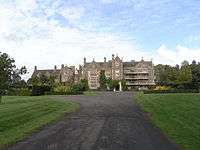

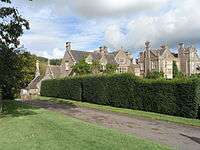
Bradfield House is a Grade I listed country house situated 2 miles (3.2 km) south-west of Uffculme in the parish of Uffculme, Devon, England.
It is one of the largest mansions in Devon,[1] having been substantially enlarged in about 1860, by the architect John Hayward, and incorporates within the Victorian structure the original mediaeval great hall, one of the largest, most ornate and best preserved in the county.
Description
The mediaeval great hall forms the core of the house and its tall windows are visible in the centre of the eastern front. The drawing room and Spanish Room were added as projecting gable wings to the south and north ends respectively in the 16th century, and these project forward beyond the original external wall of the hall. A small square porch and Oriel Room were added in 1604 and 1592 respectively and sit within the two corners formed by the projecting gables. In about 1860 a major expansion was made, by the addition of a service wing to the west, almost doubling the size of the house, and a new entrance front, with three storey central porch, was created on the south side.
Interior
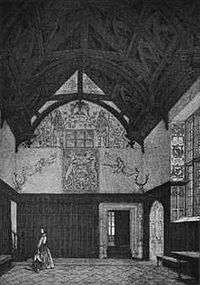
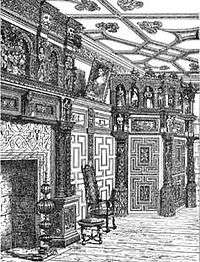
The house contains several remarkable features. The Great Hall with an early 16th-century hammerbeam roof, one of the most ornate in Devon, comparable to those at Weare Giffard Hall and Orleigh Court. It was repaired in 1860. On the wall is linen-fold paneling and a frieze of Renaissance-period heads within square panels. Several heraldic shields of members of the Walrond family impaled with the armorials of their wives are painted on the walls. The Music Room, as it was called by the Walrond family in 1910,[3] Parlour or "Spanish Room"[4] contains a highly decorated plasterwork ceiling with ribs and pendants and exceptionally elaborately carved woodwork. Above the paneling is a frieze of Spanish leather.
Grounds
The house is surrounded by parkland which retains many magnificent specimen cedar trees. The gate lodge at the entrance to the south drive remains, but is in separate ownership following the 1990s dismemberment of the estate. Nearby is the former Home Farm, with a long brick facade pierced by a tall arch leading into the yard. A stable block with bell-tower and clock is located to the west of the house. In 1875 the Walronds built All Saints Chapel, designed by Hayward, to the east of the house with roadside access, slightly to the south of the eastern entrance gate.
Bradfield Manor
The manor of Bradfield was from the 13th century until the early 20th century the principal seat of the Walrond family. Devon seats of cadet lines of this family included Bovey House in the parish of Beer, purchased c. 1670 from Sir William Pole of Shute and inherited from his first wife by John Rolle, 1st Baron Rolle (d.1842)of Bicton,[5] Dunchideock House, the inheritance of Elizabeth Pitman the wife of the 2nd Baron Waleran,[6] and Tidwell House in East Budleigh, from about 1730.[7] In 1876 the Waldron baronetcy "of Bradfield" was created for Sir John Walrond Walrond, 1st Baronet (1818-1899) and the title Baron Waleran, with variant spelling, was created for his son William Walrond, 1st Baron Waleran (1849-1925). On the death of his son the second baron in 1966, the titles became extinct and the family became extinct in the male line.
Descent of the manor
Walrond
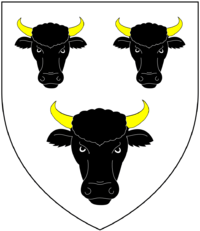
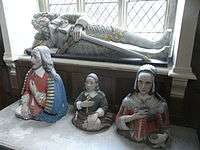
Risdon, writing in about 1630, states that the first occupier of Bradfell was Robert de Bradfell, but by the reign of King Henry III (1216-1272) Richard Walrond was lord of the manor.[10] They added to their holding through the acquisition of the manor of Hurst. The manor of Wood came to the family through their marriage to the heiress Agnes Whiting.[11] The descent of Walrond of Bradfield is thus:[12][13]
- Richard Walrond, tempore King Henry III (1216-1272). He was the son of Richard de Bradfelle, living tempore King Richard I (1189-1199)
- William I Walrond (son)
- John I Walrond (son)
- John II Walrond (son), married Joan Stofford, daughter and heiress of John Stoffard of Stoffard
- William II Walrond (son), married a certain Juliana, of unknown family.
- John III Walrond (son), married Alice Ufflett, daughter and heiress of John Ufflett by his wife Agnes Fishaker, daughter and heiress of Sir Martyn Fishaker.
- John IV Walrond (son), married Margaret Moore, daughter of John Moore (d.1510) of Moorhayes, by his wife Elizabeth Clivedon (d.1515), whose monument exists in Burlescombe Church,[14] daughter and co-heiress of John Clivedon of Willond Burlescombe, a nearby parish. Margaret's brother was Richard More (d.1516), Archdeacon of Exeter and Treasurer of Exeter Cathedral, where his monument exists.[15] John IV's 2nd son Humphry Walrond founded the Walrond family of Clist.
- John V Walrond (eldest son)
- Humphrey Walrond, married Elinor Ogan, daughter of Henry Ogan of Saltwinch, Somerset.
- Henry I Walrond (d.1550) (son), married Agnes Whitinge, 2nd daughter and co-heiress of John Whitinge (d.1529) of Woode, in the nearby parish of Kentisbeare. John Whitinge was a member of the Merchant Venturers and his elaborately panelled chest tomb survives in Kentisbeare Church, in the chapel at the east end of the south aisle, which he built. The two monumental brasses which were originally affixed to the monument are now lost, but his armorials survive sculpted on the wooden screen.[16] John Whiting left four daughters and co-heiresses.[17] Wood passed to the Walrond family, and appears to have been used as a secondary residence and dower house as several members of the family were subsequently buried in Kentisbeare Church.[18]
- Humphrey II Walrond (d.1586) (son), married Mary Willoughby (d.1556), daughter of Sir Thomas Willoughby, Justice of the Common Pleas
- William III Walrond (1558-c. 1627) (son), married Mary Sandford (d.1587), daughter of Nicholas Sandford and widow of John Warre of Somerset
- Henry II Walrond (1584-1650) (son), a lawyer admitted to the Inner Temple in 1603,[19] married Penelope Sydenham, daughter of Humphry Sydenham of Dulverton, Somerset. He was buried at Kentisbeare. He had 4 sons and 9 daughters, one of whom, Anne Walrond, in 1646 married Robert Shapcote (b. 1621), four times Member of Parliament for Tiverton in 1646-1649, 1654, 1656 and 1660 and Attorney-General for Ireland.
- William IV Walrond (1610-1667/9) (eldest son), who in 1637 married Ursula Specott (d.1698), daughter of Humphrey Specott of Launcells in Cornwall. Ursula was buried at Kentisbeare. His chest tomb exists in Bradfield Chapel, north aisle, Uffculme Church. He is shown on the left side in a relief bust below a cartouche with the Walrond arms. The arms above the relief bust figure on the right are those of Specott (Or, on a bend gules three millrinds of the first) and the ostensibly female person sculpted below, who seems to have acquired a beard and mustache, therefore appears to be Ursula his wife. Five standing female figures are shown, at the west end, a blindfolded Justice, also Faith Hope & Charity.[20] The chest tomb is complete in itself, and the half-figures presently placed on top of it belong to a former now broken up monument, probably that of the reclining Sir William Walrond (d.1689), whose effigy now occupied the window-ledge above. On the top slab is inscribed:
"This lowe built chamber to each obvious [21] eye
Seemes like a little chapell where he lye
Here in this tumbe my flesh shall rest in hope
When ere I dye this is my aime & scope".
On the front edge of the top slab is written: "1663 ffalax saepe fides testam. vota peribunt constitues tumulum si sapis ipse tuum fulim? 1663" (faith often fails, testamentary vows perish, ....).
- Sir William V Walrond (1639-1689) (son), served as a Cavalier, was knighted on 25 May 1671 at Bedford and served as Sheriff of Devon.[22] He built the chapel, no longer existing, to the north side of the house, as evidenced by a deed quoted in the "Walrond Papers" (1913): "Licence to publicly read morning and evening prayer in the chapel newly erected by William Walrond, knight, at Bradfield".[23] He died unmarried[24] but clearly intended at some time to marry Dinah Mompesson, daughter of Thomas Mompesson, Esquire, of Corton, Wiltshire, as is evidenced by the existence of a marriage settlement dated 1671/2.[25] The Walrond Papers state that no marriage took place but rather only a romance, from which there survived in 1910 a letter written on gold leaf enclosed in a petit-point jewelled envelope, with the top part of a gauntlet glove with some lady's gloves. Sir William Walrond appears to be represented by the reclining effigy dressed in a full wig and full armour in the Bradfield Chapel, Uffculme Church, which now occupies the window ledge, but was no doubt originally surrounded by an elaborate canopy, long since dismantled. His heir was his younger brother Henry.
- Col. Henry III Walrond (d.1724) (brother), who succeeded his elder brother Sir William Waldron (1639-1689). He trained as a lawyer and was admitted to the Inner Temple in 1662.[26] He was the owner of Bradfield House when William of Orange landed at Torbay on 6 November 1688. One of the Prince's generals used the house for his headquarters as is evidenced by a report written in Dutch addressed to unknown persons: "We have taken up our quarters in the house of Col. Hendric Waldron which quarters we desire shall be kept open as long as the troops of his highness shall remain in this town or neighbourhood. We have also left in the care of the aforesaid Col. Hendric Waldron two black horses and one grey mare which shall be kept for us. Signed by Sir Van Ginkel, Lt-General of the cavalry of the United Netherlands, in the service of his highness William Prince of Orange".[27] He married twice, firstly in 1698 to Elizabeth Strode, a daughter by his 1st wife of Sir William Strode (1614-1676), MP, of Newnham, Plympton St Mary and widow of Joseph (or Capt. Francis[28])Maynard of Tavistock, only surviving son of Sir John Maynard.[29] He married secondly Elizabeth Floyer (d.1749), daughter of William Floyer of Floyer Hayes in the parish of St Thomas, Exeter. The marriage was without progeny. The Floyer armorials are Sable, a chevron between three arrows argent and can be seen impaled with Walrond sculpted on the wooded pulpit in Uffculme Church, and on the chest-tomb presumed to be of his father William Walrond (d.1667/9).
- William VI Walrond (d.1745/6) (son), married Ann Courtenay, a daughter of Francis Courtenay (1652-1699) of Powderham and Forde House, Wolborough, by his wife Mary Bovey.[30] The Courtenays were the leading gentry family of Devon. Francis was the eldest son of Sir William Courtenay, 1st Baronet (d.1702), but predeceased his father and thus did not inherit the baronetcy.
- Courtenay Walrond (d.1761) (eldest son), married the daughter of a certain Mr Saunders of Bradninch but died without progeny. His heir was his younger brother Henry.
- Rev. Henry Walrond (d.1787) (brother), Rector of Woolfardisworthy, married Dorothy Milford.
- William Henry Walrond (1762-1845) (son),[31] married in 1759 Mary Alford, who left no male progeny but two daughters his co-heiresses, Margaret the youngest who died unmarried and Frances Walrond who in 1815 married Benjamin Bowden Dickinson (1793-1851), JP, DL, Sheriff of Devon in 1824, the son of John Dickinson (d.1813), by his wife Harriet Bowden, a wealthy Tiverton merchant,[32] who assumed by royal licence on the death in 1845 of his father-in-law, the name and arms of Walrond. John Dickinson was the son of Benjamin Dickinson (1737-1806), thrice mayor of Tiverton, who opened the first bank in that town near St George's Church, which he played a part in the construction of and where is located his mural monument. Benjamin's mother was of the Peard family, the sister of Oliver Peard (1700-1764), thrice mayor, "the greatest merchant who ever lived in Tiverton". He was a serge trader via Topsham with the Netherlands. In 1764 Peard tore up his will and "blasted his face off with a blunderbuss" in Fore Street, where his business was based. His fortune passed to his sister Mary, and thence to the Dickinson family.[33]
Dickinson / Walrond

- Sir John Walrond Walrond, 1st Baronet (1818-1889) (son), Conservative MP for Tiverton in 1866, born John Walrond Dickinson, who assumed the surname Walrond in 1845 at the same time as did his father. He was the son of Benjamin Bowden Dickinson (1793-1851) by his wife the heiress Frances Walrond. He was created a baronet "of Bradfield" in 1876. He married Hon. Frances Caroline Hood, daughter of Samuel Hood, 2nd Baron Bridport (1788-1868). On inheriting Bradfield House he found it in a state of disrepair and decided to restore it.[34] In about 1860 he greatly expanded the house by adding the west service wing, at the same time he restored the Tudor aspect of the east front.[35] In 1867, perhaps to assist in financing his works, he sold the Knightshayes estate, long a Dickinson possession, to the Amory family.[36] He was a benefactor of the Royal Devon and Exeter Hospital in Exeter and served as its President in 1874. His portrait by George Frederic Watts (1817–1904) survives in the hospital's collection.
- William Hood Walrond, 1st Baron Waleran (1849-1925) (son), Captain, Grenadier Guards, Lt- Col. of the Devon Rifle Volunteers, MP for East Devon in 1880, created "Baron Waleran of Uffculme" in 1905. His eldest son Hon. William Lionel Thomas Waleran (1876-1915), MP, predeceased him.
- William George Hood Walrond, 2nd Baron Waleran (1905–1966), grandson of Sir John Walrond, 1st Bt. He died without male issue, whereupon the titles and male line of Walrond of Bradfield became extinct.
Recent ownership
After having been vacated by the Walrond family, Mr Lytebaum established at Bradfield a boys' school, known as "Bradfield House School" which it remained until its closure on 23 July 1997[37] It was a residential boys' schools catering for boys with emotional and behavioural problems, the last establishment having been run by Devon County Council. In 1996 the police with child protection officers opened an investigation into allegations of sexual and physical abuse in the school, but no evidence was discovered to support such claims. In 1997, the year it of its closure, Government statistics revealed that of all youths appearing at nearby Cullompton Magistrates' Court, one third gave Bradfield House as their address.[38] The once ornate formal topiary gardens were destroyed during this period. It was then purchased by Mr de Courcy-Ling, who split up and sold the estate, and divided the house internally into 2 separate residences. In 2000, having been owned briefly by a series of speculators, the eastern half was purchased by Chrissie Fairlamb, an interior designer, and her partner Mr Colin Mills, a photographer, who sold it in 2008 to Mr Brown, a smoked-fish manufacturer from Cheshire who resides mostly in California. The western half has been owned since 2012 by Philip Dayer, a retired banker. It remains in 2013 in private ownership.
Sources
- Vivian, Lt.Col. J.L., (Ed.) The Visitations of the County of Devon: Comprising the Heralds' Visitations of 1531, 1564 & 1620, Exeter, 1895, pp. 768–770, pedigree of Walrond
- Pevsner, N., & Cherry, B., The Buildings of England: Devon, London, 2004, pp. 197–9
- Listed Building text, Bradfield House
Further reading
- Bradfield House photographic collection, c. 1850-1880, record of Victorian building works. Held by English Heritage National Monuments Record
- Hayward, John (architect), Account of building works carried out at Bradfield House, Devon c. 1860, published in: Transactions of the Exeter Diocesan Architectural Society, vol. 1, 1867, pp. 79–84
- Worthy, Charles, Devonshire Wills: A Collection of Annotated Testamentary Abstracts together with the Family History and Genealogy of Many of the Most Ancient Gentle Houses of the West of England, London, 1896, pp. 447–453, Walrond of Bradfield
References
- ↑ Pevsner, p.197
- ↑ Pevsner, p.199
- ↑ Visit to Bradfield in 1910 hosted by Hon. Lionel & Mrs Walrond, described in Report and Transactions of the Devonshire Association for the Advancement of Science, Literature and Art (re a visit to Cullompton in July 1910), vol. XLII, 1910, pp.27-30
- ↑ Pevsner
- ↑ Pevsner, p.190
- ↑ Pevsner, p.342
- ↑ Pevsner, p.347
- ↑ Burke's Landed Gentry, 1937, p.2353
- ↑ Pevsner, N., Buildings of England: Devon, 2004, p.878
- ↑ Risdon, Tristram, Survey of Devon, 1810 edition, p.84
- ↑ Risdon, Tristram, Survey of Devon, 1810 edition, p.84
- ↑ Vivian, Heraldic Visitations of Devon, 1895, pp.768-769, pedigree of Walrond of Bradfield
- ↑ Burke, John, A Genealogical and Heraldic History of the Commoners of Great Britain
- ↑ "MI" (monumental inscription) per Vivian, but location not specified, probably at Burlescombe
- ↑ Viviam, p.572, pedigree of Moore of Moorhays
- ↑ Pevsner & Cherry, Buildings of England: Devon, London, 2004, p.514
- ↑ Risdon, p.89
- ↑ Vivian, pp.768-9
- ↑ Burke
- ↑ Pevsner
- ↑ "Obvious" (i.e. passing eye, from Latin ob + via, "in the way")
- ↑ Walrond Papers, no date given
- ↑ Walrond, Charlotte Margaret Lothian, The Walrond Papers, 1913, published in Devon Notes & Queries, Vol. 8, no. 1 (1914), pp.24-26
- ↑ Vivian, p.769
- ↑ Marriage Settlement, Devon Record Office 1926 B/W/FS/21/1-2 1671 - 1672
- ↑ Vivian, p.769
- ↑ Walrond Papers, quoted in The Report and Transactions of the Devonshire Association for the Advancement of Science, Literature and Art (re a visit to Cullompton in July 1910), vol. XLII, 1910, pp.27-30
- ↑ Vivian, p.769, called Joseph in the Strode pedigree
- ↑ Vivian, p.719, pedigree of Strode of Newnham
- ↑ Vivian, p.248-9, pedigree of Courtenay
- ↑ Following descent from Burke
- ↑ Devon Record Office, Dickinson/Walrond archives: 1926 B/D/T/1/1-2 1771 (Devon Record Office, Anstey and Thompson of Exeter [1926 B/CO - 1926 B/WT]
- ↑ Details per visitor information boards "The Merchant Trail" displayed in Tiverton Town centre
- ↑ Report and Transactions of the Devonshire Association, 1910
- ↑ Pevsner, p.197
- ↑ Devon Record Office: "1926 B/D/E/6/8 1867 Contents: The Knightshayes Estate. Rough draft contract for sale (Walrond to Amory)"
- ↑ http://schooletc.co.uk/school-bradfield-house-school-113600
- ↑ http://www.thisisdevon.co.uk/Tudor-mansion-later-school-problem-children/story-11706852-detail/story.html
Coordinates: 50°52′53″N 3°20′57″W / 50.88130°N 3.34905°W